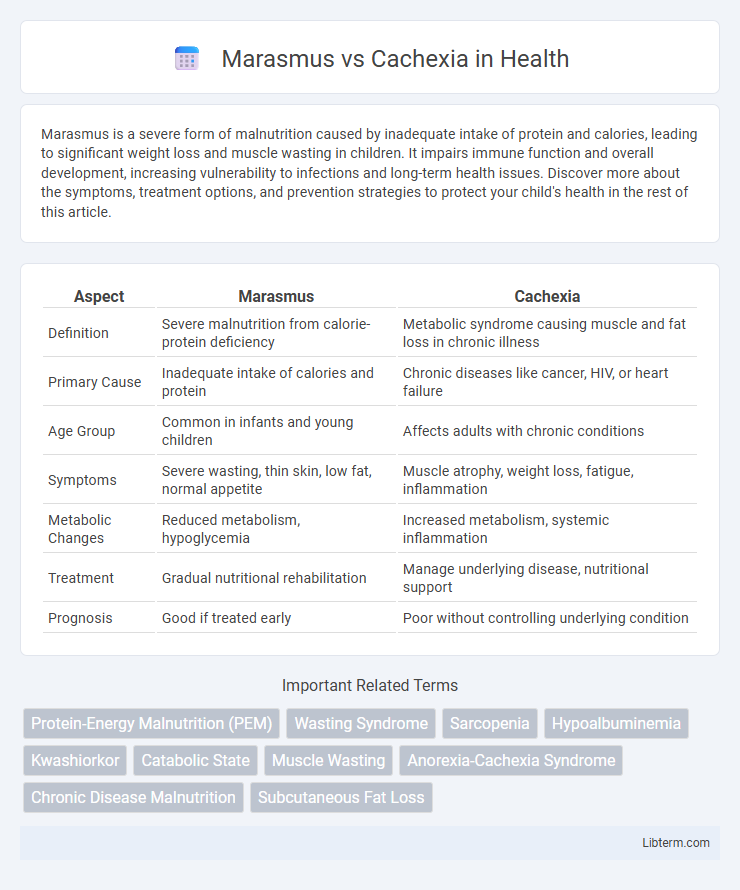Marasmus is a severe form of malnutrition caused by inadequate intake of protein and calories, leading to significant weight loss and muscle wasting in children. It impairs immune function and overall development, increasing vulnerability to infections and long-term health issues. Discover more about the symptoms, treatment options, and prevention strategies to protect your child's health in the rest of this article.
Table of Comparison
| Aspect | Marasmus | Cachexia |
|---|---|---|
| Definition | Severe malnutrition from calorie-protein deficiency | Metabolic syndrome causing muscle and fat loss in chronic illness |
| Primary Cause | Inadequate intake of calories and protein | Chronic diseases like cancer, HIV, or heart failure |
| Age Group | Common in infants and young children | Affects adults with chronic conditions |
| Symptoms | Severe wasting, thin skin, low fat, normal appetite | Muscle atrophy, weight loss, fatigue, inflammation |
| Metabolic Changes | Reduced metabolism, hypoglycemia | Increased metabolism, systemic inflammation |
| Treatment | Gradual nutritional rehabilitation | Manage underlying disease, nutritional support |
| Prognosis | Good if treated early | Poor without controlling underlying condition |
Introduction to Marasmus and Cachexia
Marasmus is a severe form of malnutrition characterized by significant loss of muscle mass and body fat due to inadequate caloric intake, commonly seen in infants and young children. Cachexia, often associated with chronic illnesses such as cancer, heart failure, and HIV/AIDS, involves systemic inflammation leading to muscle wasting despite adequate or increased caloric consumption. Both conditions result in profound weight loss and muscle atrophy but differ in their underlying causes and metabolic pathways.
Defining Marasmus: Key Features
Marasmus is a severe form of malnutrition characterized by significant wasting of muscle and fat tissue due to prolonged calorie deficiency, primarily affecting infants and young children. Key features include extreme weight loss, reduced subcutaneous fat, and a body weight less than 60% of the expected for age. Unlike cachexia, marasmus does not primarily involve inflammation or an underlying chronic disease but results from inadequate nutrient intake.
Understanding Cachexia: An Overview
Cachexia is a complex metabolic syndrome characterized by severe muscle wasting and weight loss, commonly seen in chronic illnesses such as cancer, chronic kidney disease, and heart failure. Unlike marasmus, which results primarily from calorie deficiency, cachexia involves systemic inflammation and metabolic alterations that lead to muscle catabolism despite adequate nutritional intake. Understanding the inflammatory pathways, cytokine profiles, and metabolic disruptions in cachexia is essential for developing targeted therapeutic strategies to improve patient outcomes.
Causes of Marasmus
Marasmus is primarily caused by severe protein-energy malnutrition due to inadequate caloric intake over an extended period, often seen in children with insufficient breastfeeding or food availability. This condition results from a significant deficiency in total dietary energy, leading to muscle wasting and fat loss. Unlike cachexia, which is driven by chronic disease-related inflammation and metabolic alterations, marasmus stems mainly from outright starvation and nutrient deprivation.
Causes of Cachexia
Cachexia primarily arises from chronic inflammatory diseases such as cancer, chronic heart failure, chronic kidney disease, and chronic obstructive pulmonary disease (COPD), which trigger a complex metabolic syndrome involving inflammatory cytokines like TNF-a and IL-6. Unlike marasmus, which results from pure caloric deficiency, cachexia involves metabolic alterations including increased muscle protein breakdown and impaired appetite regulation driven by systemic inflammation. This cytokine-induced catabolic state leads to severe muscle wasting despite adequate or increased caloric intake.
Clinical Manifestations: Marasmus vs Cachexia
Marasmus presents with severe muscle wasting, prominent ribs, and loss of subcutaneous fat, primarily caused by calorie deficiency, while cachexia features profound muscle atrophy, systemic inflammation, and weight loss linked to chronic diseases such as cancer or heart failure. Clinical manifestations of marasmus include dry skin, diarrhea, and irritability, whereas cachexia typically involves edema, fatigue, and elevated inflammatory markers like C-reactive protein. Muscle loss in marasmus is more generalized and related to energy depletion, whereas cachexia involves metabolic disturbances driven by cytokines such as TNF-alpha and IL-6.
Diagnostic Criteria and Assessment
Marasmus is diagnosed primarily through clinical assessment emphasizing severe muscle wasting, low weight-for-age, and absence of edema, commonly identified in infants with inadequate caloric intake. Cachexia diagnosis involves identifying unintentional weight loss exceeding 5% over 12 months, reduced muscle strength, fatigue, and systemic inflammation markers, often associated with chronic diseases such as cancer or heart failure. Assessment tools for marasmus include anthropometric measurements like mid-upper arm circumference and skinfold thickness, whereas cachexia evaluation incorporates biochemical markers, body composition analysis, and evaluation of inflammatory cytokines.
Pathophysiological Differences
Marasmus results from a severe deficiency in caloric intake leading to extensive depletion of fat and muscle stores, primarily affecting energy metabolism and causing reduced basal metabolic rate. Cachexia involves complex metabolic disturbances driven by systemic inflammation, often associated with chronic diseases like cancer or heart failure, characterized by increased protein catabolism and muscle wasting despite adequate nutritional intake. Unlike marasmus, cachexia features pro-inflammatory cytokines such as TNF-alpha and IL-6 that mediate muscle degradation and altered lipid metabolism.
Treatment Approaches and Management
Marasmus treatment centers on aggressive nutritional rehabilitation through high-calorie, protein-rich diets and gradual refeeding to restore body weight and muscle mass. Cachexia management involves addressing the underlying disease, using anti-inflammatory agents, appetite stimulants, and anabolic therapies to counteract muscle wasting and systemic inflammation. Both conditions require personalized care plans incorporating medical, nutritional, and psychological support to improve patient outcomes and quality of life.
Prognosis and Prevention Strategies
Marasmus prognosis is generally favorable with timely nutritional rehabilitation focusing on caloric and protein intake, whereas cachexia prognosis is often poor due to underlying chronic diseases like cancer or heart failure complicating treatment. Prevention strategies for marasmus emphasize early detection of malnutrition and adequate infant feeding practices, while cachexia prevention involves managing chronic disease progression and anti-inflammatory interventions to mitigate muscle wasting. Both conditions require multidisciplinary approaches, but cachexia entails more complex management targeting systemic inflammation and metabolic abnormalities.
Marasmus Infographic

 libterm.com
libterm.com